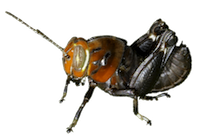Taxonomy
Family: Gryllidae
Subfamily: NemobiinaeTribe: PteronemobiiniSynonym: Nemobius fasciatus funeralis, Allonemobius funeralis Comments: One of ten species in this genus, all of which occur in North America north of Mexico (Cigliano et al., 2017). Eight species have been recorded in North Carolina.Species Status: The Orthoptera Species File treats Allonemobius griseus griseus and A. g. funeralis as subspecies. Some authors, including SINA, however, treat them as full species. We follow OSF in this regard.
Identification
Field Guide Descriptions: Online Photographs: BugGuide , Google Images ,
iNaturalist , GBIF Technical Description, Adults/Nymphs: Hebard (1913) Comments: A dark brown ground cricket with a suffusion of gray (Hebard, 1913). The face below the antennae is shining black, contrasting with the top of the head that has alternating dark and pale stripes similar to those of other members of this genus. The body and wings are dark but distinctively covered with grayish hair. The nominate subspecies is similar but is not as dark brown.Total Length [body plus wings; excludes ovipositor]: 7.9 mm, type female (Hebard, 1913)Structural Features: Hindwings were reported to be absent by Hebard (1913), but Fulton (1931) lists both griseus and funeralis among species possessing long-winged forms. Fulton also noticed, however, that a long-winged male lost its wings shortly after being caged. The ovipositor in funeralis is fairly short, approximately 3/4 the length of the hind femur. This is the main structural difference from the nominate subspecies, where the ovipostor is about 1/4 longer than the hind femur (Hebard, 1913).Singing Behavior: Fulton (1931) described the song of funeralis as a "low, weak buzz with a faint, shrill overtone". Irregular breaks occur at roughly 5-10 second intervals, but the trills can be continuous for up to 15-30 seconds. Following a break, the song starts off softly then undergoes a crescendo from a third to half a second, after which the amplitude remains steady. Spectrograms for subspecies funeralis appear to be absent, but those shown for subspecies griseus on SINA and the Macaulay Library show a dominant pitch of over 8 kHz and with approximately 30-40 pulses produced per second. One possible difference, however, is that the song of the nominate subspecies shows breaks at regular intervals (see examples in the Macaulay Library), with each trill lasting only about 1.5 seconds, which is much shorter than what Fulton described for funeralis. Fulton noted that the sound quality is similar to that of Eunemobius carolinus, although that species shows more irregular amplitude modulation and often has a beat produced by groupings of pulses. The dominant pitch for carolinus is additionally much lower, around 6.1 kHz (Walker, 2017). More similar is the song of Neonemobius cubensis, which is also a high pitched trill that increases in amplitude; the pulse rate of that species, however, is much higher, mostly above 42 pulses per second. The songs of Allonemobius fultoni also show a similar increase in amplitude, but the trills of those species are shorter in length, lower in pitch, and have a slower within-trill pulse rate.Recording playback at normal speed.
Download Video:
"MP4"

 »
»
 »
»